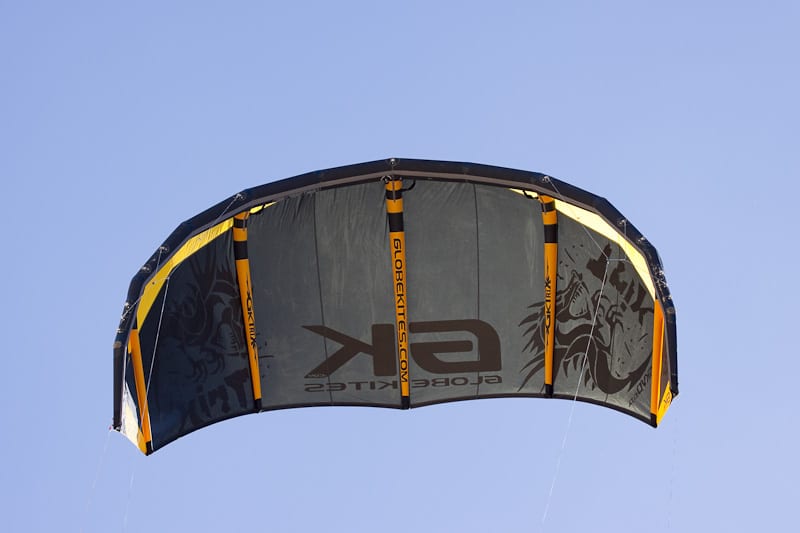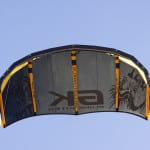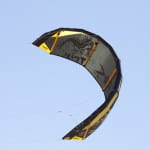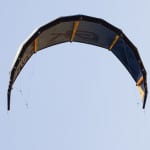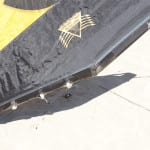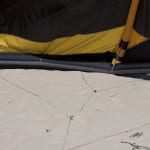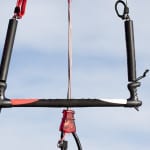GK Trix
TESTED: 9m
AVAILABLE SIZES: 5.5, 7, 9, 12, 15m
TESTED IN: Central California, 18-24 knots, small-medium waves

FROM THE MANUFACTURER:
The 2011 GK Trix is a medium aspect ratio kite with full depower and adjustable bar pressure and turning speed. The GK Trix is perfect for wave riding and freestyle as it is a very stable kite with easy relaunch. It is perfect for beginners and allows riders to use the same kite through their entire learning curve to a top riding level. The 2011 GK kites, both the GK Trix and GK Sonic, are the result of over 10 years of kite design. The 2011 GK kites have retained their profile and overall shape while some details have been changed to refine performance and adjustability. The Trix features the AKPO (Adjustable Kite Power Optimizer) bridle adjustments to allow the rider to tune the kite’s bar pressure, turning speed, and performance in low wind.
THE KITEBOARDER REPORT:
Out of the Box: The 2011 GK Trix looks very similar to last year’s model. This is a five-strut one-pump kite with a unique and very adjustable bridle. The rear lines can be moved to change the kite’s turning speed and the front bridle can be adjusted to change bar pressure and the overall flying characteristics of the kite. The front bridle features two pulleys per side and the rear lines connect directly to the kite. The construction of the leading edge of the Trix is very heavy duty and features a webbing reinforcement over the seam. This kite comes with a humongous kite bag that should easily allow you to bring all your gear for the day to the beach.
The 2011 GK bar is essentially the same as the 2010 bar, but the quick release now has a small trigger to make it easier to reassemble than last year. The bar features a push away quick release, adjustable stopper, above bar depower strap, and a molded grip. Our 9m test kite came with a 53 cm bar and 21m lines.

On the Water: We initially rode the Trix with the bridle on the F2-F4 settings and the kite was very responsive and smooth through the air. The Trix has good feedback and bar pressure that starts out light and gets heavier the more powered up you are. It sits back in the window and holds power though turns, even when looping the kite. Jumping is easy and predictable. We then changed the bridle settings to F3-F6 and the Trix felt completely different. On that setting, the Trix flew further upwind with lighter bar pressure, turned slower, and had very little feedback. The depower was much smoother than on the F3-F6 setting, but it didn’t seem to depower as much as on the F2-F4 setting. On both settings the Trix was easy to relaunch.
PROS:
- The highly adjustable AKPO bridle allows you to drastically change the Trix’s flying characteristics to your personal liking or the day’s riding conditions.
- The Trix has very responsive and smooth handling with the bridle on the F2-F4 settings.
CONS:
- The highly adjustable bridle means that it’s you that’ll have to spend time changing settings and testing to see what you like the best.
- The Trix doesn’t have great low-end power.
THE VERDICT:
The 2011 Trix is a very adjustable kite, but our test team liked it the most on the F2-F4 setting. The Trix is well-suited for riders who like a smooth turning, direct-feeling, and predictable kite. The Trix’s responsive handling and stability make it a great wave riding kite. The adjustable A-KPO bridle is interesting and can make the Trix feel like two kites in one if you like to spend time changing bridle settings. It doesn’t have the best upwind or boosting performance, but is a great all-around kite that suits wave or wakestyle riding well.
TIPS:
- Try the different bridle settings. They drastically change how the kite feels.
- To get a little more low-end range out of the Trix, consider using a line set longer than the stock 21m lines.
TESTER COMMENT:
“I was shocked by how drastically the Trix’s flying characteristics changed when we moved the front bridle to different settings. After just a few minutes of adjusting, it felt like a completely different kite.” ”“Paul Lang, 200 lbs., Surf Kiter


